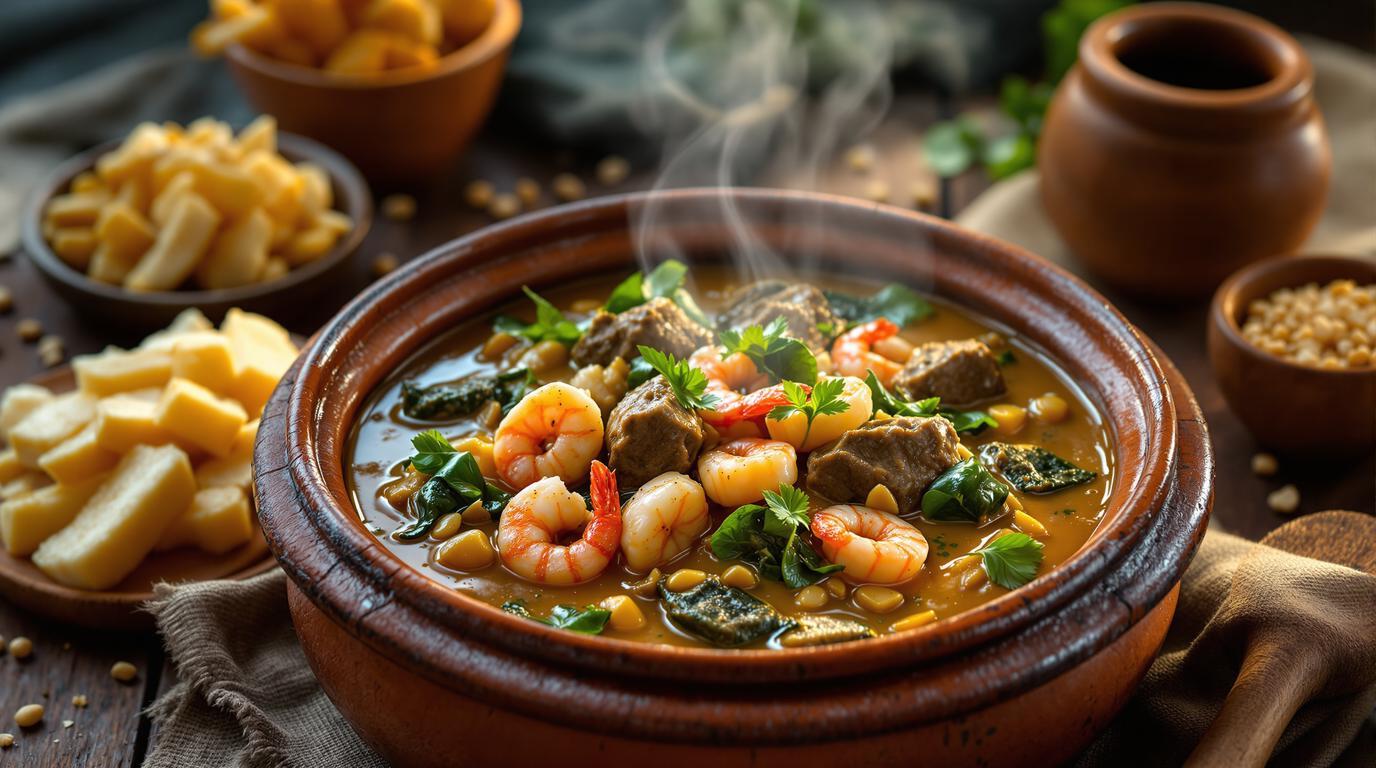There’s something magical about dishes that stretch across generations, recipes that hold stories of family gatherings and cultural celebrations. Ndolé, Cameroon’s beloved national dish, is one such culinary treasure. Growing up in my grandmother’s kitchen, I learned that true cooking isn’t just about following recipes—it’s about understanding the harmony of flavors that make a dish sing. Ndolé exemplifies this beautifully with its balance of bitter greens, creamy peanut sauce, and tender meat that creates a symphony of tastes that has united Cameroonians across regions for centuries.
The Story Behind Ndolé 📖
Ndolé originated with the Douala people in Cameroon’s coastal Littoral region before becoming a beloved national dish. What fascinates me about this stew is how it represents Cameroon’s cultural diversity—a country often called “Africa in miniature” for its incredible variety of landscapes and traditions. The dish’s name comes from the Douala word for bitter leaves, the signature ingredient that gives the stew its distinctive character.
I first encountered authentic Ndolé while traveling through West Africa, where a local grandmother taught me her family’s version, passed down through five generations. She showed me how proper preparation of the bitter leaves is an art form in itself—a technique I’m excited to share with you today.
Essential Ingredients 🧾
For 4-6 generous servings, you’ll need:
- 2.2 lbs (1 kg) bitter leaves, fresh or dried (substitute: blanched spinach*)
- 1½ cups (150g) raw, shelled peanuts
- 2.2 lbs (1 kg) beef chunks (traditional choices include beef, cow foot, or dried fish)
- 2-3 tablespoons crayfish powder (essential for authentic flavor)
- 1 lb (500g) shrimp (optional)
- 2 medium onions, finely chopped
- 4 bouillon cubes (Maggi is traditional)
- 2-3 whole habanero peppers
- 1 cup vegetable oil (can be reduced for a lighter version)
- Salt and nutmeg to taste
*While spinach works in a pinch, it lacks the characteristic bitterness that defines traditional Ndolé. If using spinach, add a splash of lemon juice to mimic some of that bitter complexity. For a truly authentic experience, check African grocery stores for frozen bitter leaves—they’re increasingly available in international markets.
Step-by-Step Instructions 📝
1. Prepare the bitter leaves – This crucial first step determines the final flavor balance of your Ndolé:
Soak the bitter leaves in cold water with 2 teaspoons of baking soda (traditionally called ‘Kawa’ or limestone). Bring to a boil for 5 minutes, then rinse thoroughly in cold water. Squeeze out excess moisture with your hands. This process removes excessive bitterness while preserving the leaves’ essential character.
2. Cook the meat until tender:
Place beef in a large pot with one chopped onion, one whole habanero pepper, 2 bouillon cubes, and enough water to cover. Simmer for 40-50 minutes at 185°F (85°C) until the meat yields easily to a fork but still holds its shape. Reserve the broth—this liquid gold carries tremendous flavor!
3. Prepare the peanut paste:
While the meat simmers, boil raw peanuts for about 20 minutes until soft. Drain and blend with half an onion, a small piece of habanero (adjust to your heat preference), and enough water to form a smooth, pourable paste—similar to the consistency of heavy cream.
Chef’s Note: The texture of your peanut paste is critical—too thick and your stew becomes gluey; too thin and you’ll lose the luxurious mouthfeel that makes Ndolé special. Aim for a consistency that coats the back of a spoon but still drips off easily.
4. Combine and build flavor:
Add the peanut paste to the pot with the meat and broth. Stir in crayfish powder (this ingredient is non-negotiable for authentic flavor), remaining bouillon cubes, salt, and ground pepper. Simmer gently for 15 minutes at 175°F (80°C), stirring frequently to prevent the bottom from burning.
5. Incorporate bitter leaves:
Fold in the prepared bitter leaves and simmer for another 10-15 minutes on low heat (160°F/70°C). The stew should thicken slightly but remain silky and pourable.
6. Prepare the finishing touch:
In a separate pan, sauté the remaining onion in hot oil until translucent. If using shrimp, add them now and cook until pink and just done. Pour this aromatic oil and onion mixture over the stew just before serving—this traditional technique adds incredible depth.
Serving & Presentation Tips 🍽️
In Cameroon, Ndolé is traditionally served with miondo (steamed cassava sticks) or bobolo (fermented cassava wrapped in leaves). Fried plantains or boiled yams make excellent alternatives that are easier to find. For a complete experience, try pairing your Ndolé with a sparkling wine like Crémant to balance the rich peanut sauce, or a light fruity red like Beaujolais to complement the meaty elements.
When I make Ndolé for my family, I like to serve it in a large communal bowl with side dishes arranged around it—this honors the traditional Cameroonian way of bringing people together through food. If you’re looking for more quick but authentic recipes, you might enjoy my Crispy Italian Spinach Flatbreads or this warming Moroccan Chickpea Stew.
For a complete meal, consider making some homemade butter using Grandma’s 15-minute butter churning trick to spread on 30-minute homemade bread, or serve with my quick 10-minute skillet spaghetti for a fusion feast.
Remember that cooking is more than following instructions—it’s about connecting with traditions and creating memories. As we say in professional kitchens, “Cook with your heart first, then your hands.” Ndolé isn’t just a dish; it’s a celebration of Cameroon’s vibrant culture and the power of food to bring people together across generations. Bon appétit! 🍲
